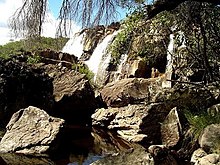Chapada dos Veadeiros
| Cerrado Protected Areas: Chapada dos Veadeiros and Emas National Parks | |
|---|---|
| Name as inscribed on the World Heritage List | |
 |
|
| Location | Brazil |
| Type | Natural |
| Criteria | ix, x |
| Reference | 1035 |
| UNESCO region | Latin America and the Caribbean |
| Coordinates | 14°05′S 47°40′W / 14.083°S 47.667°WCoordinates: 14°05′S 47°40′W / 14.083°S 47.667°W |
| Inscription history | |
| Inscription | 2001 (25th Session) |
Chapada dos Veadeiros National Park (Portuguese: Parque Nacional da Chapada dos Veadeiros) is a national park of Brazil located in the Chapada dos Veadeiros, an ancient plateau with an estimated age of 1.8 billion years. Based in the Brazilian state of Goias, the park was created on January 11, 1961 by President Juscelino Kubitscheck, and listed as a World Heritage Site by Unesco in 2001. It occupies an area of 655 square kilometres (253 sq mi) in the municipalities of Alto Paraíso de Goiás, Cavalcante and Colinas do Sul. The park is maintained by Chico Mendes Institute for Biodiversity Conservation.
The average yearly temperature is 24-26 degrees Celsius, ranging from a minimum of 4-8 degrees Celsius and reaching a maximum of 40-42 degrees Celsius.
With altitudes between 600 and 1650 meters, it is the highest plain in Central Brazil. The highest point of the park and of the state of Goiás is Serra da Santana, at 1691 meters above sea level.
Its rock formations are one of the oldest on the planet. There are quartz with outcrops of crystals. These rocks are exported and appreciated in Japan and England, where for some decades they were used for industrial work. Nowadays therapists and nature lovers seek energies and the power to cure from the crystals and from places like Alto Paraiso.
Rock crystals are present in the soil of the rich cerrado, or open pasture. Forest growth is also still found in the region, where more than 25 species of orchids can be found, besides other Brazilian species such as pau d'arco roxo, copaíba (copa tree), aroeira (California pepper tree), tamanqueira (cork tree), terivá (a variety of palm tree), buritis (wine-palm) and Babaçu (Babassu).
...
Wikipedia

